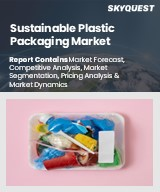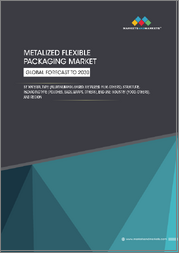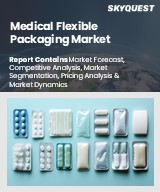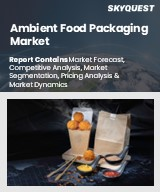
|
시장보고서
상품코드
1386021
세계 연포장 시장 평가 : 재료 유형별, 제품 유형별, 최종 사용자별, 지역별, 기회 및 예측(2016-2030년)Flexible Packaging Market Assessment, By Material Type, By Product Type, By End-user, By Region, Opportunities, and Forecast, 2016-2030F |
||||||
세계 연포장 시장 규모는 2022년 3,170만 톤에서 2030년 4,613만 톤에 이르렀으며, 2023년-2030년 예측기간에 CAGR로 4.8%의 성장이 예측되고 있습니다. 연포장 부문은 식품, 음료, 퍼스널케어 등 주요 최종 이용 산업에 의해 추진되어 큰 성장을 보이고 있습니다. 제품의 신선도와 보존 가능 기간이 가장 중요한 식품 및 음료 부문에서는 소비자는 식품의 품질과 안전성을 유지하면서, 편리하고 외형에도 아름다운 포장을 요구하고 있습니다. 연포장은 외부 요인으로부터 보호하는 장벽을 제공하며 풍미, 영양가 및 신선품의 신선도를 보장하는 능력으로 이러한 모든 요구 사항을 충족합니다.
마찬가지로 퍼스널케어 부문에서는 로션, 크림, 샴푸, 화장품 등 다양한 제품 유형에 적응하는 범용성의 높이에서 연 포장이 크게 활용되고 있습니다. 퍼스널케어 브랜드는 차별화와 효과적인 브랜딩을 가능하게 하는 연포장의 맞춤형 디자인 옵션으로부터 혜택을 누리고 있습니다. 또한 소비자와 브랜드가 환경 친화적 인 포장 솔루션을 찾고 있기 때문에 지속가능성 측면은 이러한 부서에서 모두지지를 받고 있습니다. 연포장은 경량으로 재활용 가능한 경우가 많기 때문에 지속가능성의 목표나 규제의 대처에 맞추어 환경의식이 높은 소비자에게 어필할 수 있습니다. 또한 전자상거래의 성장은 특히 이러한 최종 이용 산업의 상황에서 연포장 부문에 큰 영향을 미칩니다.
퍼스널케어 수요 증가가 연포장의 요구를 촉진
뷰티 케어 부문은 오늘날 시장에서 연포장 수요를 홍보하는 중요한 카탈리스트입니다. 연포장은 소비자를 매료시키는 심미적이고 혁신적인 포장 디자인에 기여하며 효율적인 제품 보호 및 보존 수요에 도움이 됩니다. 게다가, 연포장의 경량으로 운반하기 쉬운 성질은 미용 케어 산업에 특히 적합하고, 편리한 사용성을 요구하는 소비자의 욕구에 잘 어울립니다. 게다가 산업은 지속가능성에 대한 대처가 높아지고 있어 소비자의 선호에 맞추어야 하기 때문에 환경친화적인 연포장 솔루션의 채용이 진행되고 있습니다.
식품 및 음료 부문의 호조한 업적이 연포장의 이용을 높인다.
연포장 시장의 성장은 식품 및 음료 부문에 의해 크게 촉진되고 있습니다. 연포장은 소비자에게 편리하고 가볍고 휴대가능하며 환경 친화적이고 재활용 가능한 솔루션을 제공합니다. 또한 효과적인 장벽 특성을 제공하고 보존 가능 기간을 연장하며 식품 및 음료의 신선도를 유지합니다. 식품 및 음료 산업에 있어서의 전자상거래 대두는 연포장의 중요성을 한층 더 부조로 하고 있어 제품의 품질을 유지하면서, 내구성이 있는 효율적인 수송에 불가결한 것이 되고 있습니다. 게다가, 연포장과 관련된 비용 절감과 재료의 절약으로 인해, 연포장은 제조자에게 선호되는 선택이 되었습니다.
엄격한 식품안전기준은 연포장 수요 증가
연포장 제조업체는 엄격한 식품안전규제를 엄수하는 것을 우선하여 식품 및 음료의 무결성과 안전성을 보증하고 있습니다. 또한, 제조업체는 신선품의 보존 가능 기간을 효과적으로 연장하는 포장 솔루션의 개발에도 주력하고 있습니다. 이러한 적극적인 접근은 품질을 유지할 뿐만 아니라 식품 폐기물을 줄이고 지속가능성 목표에 따라 폐기 식품과 관련된 경제적 손실을 최소화하는 데 중요한 역할을 합니다.
COVID-19의 영향
COVID-19의 유행은 연포장 시장에 긍정적인 영향을 미쳤습니다. 세계적으로 COVID-19와 관련된 규제로 인해 사람들이 집에 머물렀기 때문에 포장 식품 및 포장 음료 수요가 현저히 증가했습니다. 이 급증은 소비자가 위생과 편의성을 선호하는 식품 부문에서 연포장의 생산과 소비 증가를 촉진하고 유행 중에 연포장 수요를 촉진했습니다. 그러나 록다운, 운송제한, 노동력 부족은 생산과 유통에 영향을 주었으며 연포장 재료와 완제품 공급에 지연과 부족을 초래했습니다.
미래 전망
지속가능성 목표에 대한 세계의 주목 증가는 지속가능한 포장재료의 개선을 위한 협력에 박차를 가하고 있습니다. 예를 들어, Mondi는 프랑스 기계 제조업체인 Thimonnier와 협력하여 2022년 4월 플라스틱 폐기물을 줄이는 친환경 포장 솔루션을 개발했습니다.
주요 기업의 동향과 전망
연포장 업계의 유력 기업은 환경의 지속가능성을 우선하는 소비자 부문의 확대에 대응하기 위해 재활용 가능하고 환경적으로 지속 가능한 솔루션에 전략적으로 투자하고 도입하고 있습니다.
이 보고서는 세계 연포장 시장에 대한 조사 분석을 통해 시장 규모와 예측, 시장 역학, 주요 기업 현황과 전망 등을 제공합니다.
목차
제1장 조사 방법
제2장 프로젝트의 범위와 정의
제3장 연포장 시장에 대한 COVID-19의 영향
제4장 주요 요약
제5장 고객의 목소리
- 시장의 인지도와 제품 정보
- 브랜드 인지도와 충성도
- 구매 결정에서 고려되는 요소
- 구매 빈도
- 구입 매체
제6장 연포장 시장 전망(2016-2030년)
- 시장 규모와 예측
- 금액
- 수량
- 재료 유형별
- 플라스틱
- 종이
- 알루미늄박
- 기타
- 제품 유형별
- 파우치
- 봉지
- 필름
- 랩
- 기타
- 최종 사용자별
- 식품 및 음료
- 화장품 및 퍼스널케어
- 의약품
- 가사
- 산업
- 기타
- 지역별
- 북미
- 유럽
- 남미
- 아시아태평양
- 중동 및 아프리카
제7장 연포장 시장 전망 : 지역별(2016-2030년)
- 북미
- 시장 규모와 예측
- 재료 유형별
- 제품 유형별
- 최종 사용자별
- 미국
- 캐나다
- 멕시코
- 유럽
- 독일
- 프랑스
- 이탈리아
- 영국
- 러시아
- 네덜란드
- 스페인
- 터키
- 폴란드
- 남미
- 브라질
- 아르헨티나
- 아시아태평양
- 인도
- 중국
- 일본
- 호주
- 베트남
- 한국
- 인도네시아
- 필리핀
- 중동 및 아프리카
- 사우디아라비아
- 아랍에미리트(UAE)
- 남아프리카
제8장 공급측 분석
- 생산 능력 : 기업별
- 생산 : 기업별
- 운전 효율 : 기업별
- 주요 공장의 소재지(최대 25)
제9장 시장 매핑(2022년)
- 재료 유형별
- 제품 유형별
- 최종 사용자별
- 지역별
제10장 거시적 환경과 산업 구조
- 수급 분석
- 수출입 분석 - 수량과 금액
- 공급/가치 체인 분석
- PESTEL 분석
- Porter's Five Forces 분석
제11장 시장 역학
- 성장 촉진요인
- 성장 억제요인(과제, 성장 억제요인)
제12장 주요 기업 정세
- 마켓 리더 상위 5개사의 경쟁 매트릭스
- 마켓 리더 상위 5개사 시장 수익 분석(2022년)
- 합병과 인수/합작사업(해당하는 경우)
- SWOT 분석(시장 참가 기업 5사용)
- 특허 분석(해당하는 경우)
제13장 가격 분석
제14장 사례 연구
제15장 주요 기업의 전망
- Amcor plc
- Sonoco Products Company
- Berry Global Inc
- Transcontinental Inc
- Mondi
- Sealed Air
- Coveris
- Huhtamaki
- Constantia Flexibles
- Bischof Klein SE & Co. KG
제16장 전략적 권장사항
제17장 당사에 대하여 면책사항
JHS 23.12.04Flexible Packaging Market size was recorded at 31.7 million tons in 2022, which is expected to grow to 46.13 million tons in 2030 with a CAGR of 4.8% for the forecast period between 2023 and 2030. The flexible packaging sector is witnessing substantial growth propelled by key end-use industries such food and beverages and personal care. In the food and beverages sector, where product freshness and shelf life are paramount, further consumers seek packaging that maintains the quality and safety of the food while also being convenient and visually appealing. All these demands are met by flexible packaging by its ability to provide a protective barrier against external elements, ensuring the preservation of flavour, nutritional value, and freshness of perishable products.
Similarly, in the personal care sector, flexible packaging is highly utilized due to its versatility and adaptability to various product types such as lotions, creams, shampoos, and cosmetics. Personal care brands benefit from flexible packaging's customizable design options that enable differentiation and effective branding. Furthermore, the sustainability aspect is gaining traction in both these sectors, with consumers and brands seeking eco-friendly packaging solutions. Flexible packaging, being lightweight and often recyclable, aligns with sustainability goals and regulatory initiatives, appealing to environmentally conscious consumers. Additionally, the growth in e-commerce has also significantly impacted the flexible packaging sector, especially in the context of these end-use industries.
Rising Personal Care Demand to Drive the Need for Flexible Packaging
The beauty care sector is a significant catalyst driving the demand for flexible packaging in today's market. Flexible packaging contributes to aesthetically pleasing and innovative packaging designs to attract consumers and abets in demand efficient product protection and preservation. Additionally, flexible packing's lightweight and portable nature make it particularly suitable for the beauty care industry, aligning well with the consumer's desire for convenient usability. Furthermore, the industry's growing commitment to sustainability and the need to align with consumer preference is encouraging the adoption of eco-friendly flexible packaging solutions.
For instance, the beauty product sales in the United States increased by 10% in Q1 of 2023 compared to Q1 2022. The rising sales of beauty care commodities in several countries such as United States, India and China contributes to growing demand for flexible packaging.
Strong Performance of Food and Beverages Sector Raises the Usage of Flexible Packaging
The growth of the flexible packaging market is significantly driven by the food and beverages sector. Flexible packaging provides consumers with convenient, lightweight, portable, eco-friendly, and recyclable solutions. Moreover, it offers effective barrier properties that extend the shelf life and maintain the freshness of food and beverage products. The rise of e-commerce in the food and beverage industry has further underscored the importance of flexible packaging, making it essential for durable and efficient transportation of products while maintaining their quality. Additionally, the cost-effectiveness and material savings associated with flexible packaging make it a favourable choice for manufacturers.
For instance, the total milk production in 2022 increased to 2,26,462 from 2,26,293 during 2021 in the United States. These growth in production rates of several food products increases the demand for flexible packaging across the globe.
Stringent Food Safety Standards to Increase Flexible Packaging Demand
Flexible packaging manufacturers prioritize strict adherence to stringent food safety regulations, ensuring the integrity and safety of food and beverage products. Additionally, manufacturers focus on developing packaging solutions that effectively extend the shelf life of perishable items. This proactive approach not only upholds quality but also plays a crucial role in reducing food waste, aligning with sustainability goals, and minimizing economic losses associated with discarded food products.
For instance, in July 2023, the European Union set new targets on food wastage, which is to achieve a 50% reduction in per capita food waste within retail and among consumers by 2030. These kind of target implementations in several EU countries is expected to raise the need for flexible packaging.
Impact of COVID-19
The COVID-19 pandemic had a positive impact towards the flexible packaging market. At global scale, there was a notable increase in the demand for packaged food and beverages as individuals remained at home due to COVID related restrictions. This surge drove a higher production and consumption of flexible packaging within the food sector where consumers prioritized hygiene and convenience which led to a preference for single-use and smaller packaging designs driving flexible packaging demand during the pandemic. However, lockdowns, transportation limitations, and labour shortages affected production and distribution, leading to delays and shortages in the supply of flexible packaging materials and finished products.
Future Outlook
The escalating global focus on sustainability objectives has spurred collaborative efforts to improve sustainable packaging materials. For instance, Mondi partnered with the French machinery manufacturer Thimonnier to develop an eco-friendly packaging solution that reduces plastic waste in April 2022.
Similarly, Berry Global and LyondellBasell joined forces to accelerate their objective of achieving 100% sustainable sourcing for customer-facing packaging by 2026. This collaboration aims to transition from plastic-lined paper cups, which have limited recyclability, to single-substrate, clear plastic drink cups, making recycling more accessible for a broader consumer base.
Key Players Landscape and Outlook
Prominent players in the flexible packaging industry are strategically investing in and introducing recyclable and environmentally sustainable solutions to meet the expanding consumer segment that prioritizes environment sustainability.
For instance, in February 2022, Mondi and Henkel have joined forces to introduce a fully recyclable mono-material refill pouch for Henkel's Pril brand. This initiative aligns with Henkel's business sustainability objectives of achieving 100% recyclability or reusability in its packaging and reducing fossil-based virgin plastic usage by 50% before the year 2025.
In April 2023, Yash Pakka Ltd., a compostable packaging industry pioneer announced the development of its first overseas plant in Guatemala, which is set to be operational by mid-2025. This plant will produce flexible packaging as one of its primary offerings.
Table of Contents
1. Research Methodology
2. Project Scope & Definitions
3. Impact of COVID-19 on Flexible Packaging Market
4. Executive Summary
5. Voice of Customer
- 5.1. Market Awareness and Product Information
- 5.2. Brand Awareness and Loyalty
- 5.3. Factors Considered in Purchase Decision
- 5.3.1. Brand Name
- 5.3.2. Quality
- 5.3.3. Quantity
- 5.3.4. Price
- 5.3.5. Product Specification
- 5.3.6. Application Specification
- 5.3.7. VOC/Toxicity Content
- 5.3.8. Availability of Product
- 5.4. Frequency of Purchase
- 5.5. Medium of Purchase
6. Flexible Packaging Market Outlook, 2016-2030F
- 6.1. Market Size & Forecast
- 6.1.1. By Value
- 6.1.2. By Volume
- 6.2. By Material Type
- 6.2.1. Plastics
- 6.2.1.1. LLDPE
- 6.2.1.2. LDPE
- 6.2.1.3. PP
- 6.2.1.4. PET
- 6.2.1.5. Vinyl
- 6.2.1.6. PS
- 6.2.1.7. Others
- 6.2.2. Paper
- 6.2.3. Aluminium Foil
- 6.2.4. Others
- 6.2.1. Plastics
- 6.3. By Product Type
- 6.3.1. Pouches
- 6.3.2. Bags
- 6.3.3. Films
- 6.3.4. Wraps
- 6.3.5. Others
- 6.4. By End-user
- 6.4.1. Food & Beverages
- 6.4.2. Cosmetics & Personal Care
- 6.4.3. Pharmaceuticals
- 6.4.4. Household Care
- 6.4.5. Industrial
- 6.4.6. Others
- 6.5. By Region
- 6.5.1. North America
- 6.5.2. Europe
- 6.5.3. South America
- 6.5.4. Asia-Pacific
- 6.5.5. Middle East and Africa
7. Flexible Packaging Market Outlook, By Region, 2016-2030F
- 7.1. North America*
- 7.1.1. Market Size & Forecast
- 7.1.1.1. By Value
- 7.1.1.2. By Volume
- 7.1.2. By Material Type
- 7.1.2.1. Plastics
- 7.1.2.1.1. LLDPE
- 7.1.2.1.2. LDPE
- 7.1.2.1.3. PP
- 7.1.2.1.4. PET
- 7.1.2.1.5. Vinyl
- 7.1.2.1.6. PS
- 7.1.2.1.7. Others
- 7.1.2.2. Paper
- 7.1.2.3. Aluminium Foil
- 7.1.2.4. Others
- 7.1.3. By Product Type
- 7.1.3.1. Pouches
- 7.1.3.2. Bags
- 7.1.3.3. Films
- 7.1.3.4. Wraps
- 7.1.3.5. Others
- 7.1.4. By End-user
- 7.1.4.1. Food & Beverages
- 7.1.4.2. Cosmetics & Personal Care
- 7.1.4.3. Pharmaceuticals
- 7.1.4.4. Household Care
- 7.1.4.5. Industrial
- 7.1.4.6. Others
- 7.1.5. United States*
- 7.1.5.1. Market Size & Forecast
- 7.1.5.1.1. By Value
- 7.1.5.1.2. By Volume
- 7.1.5.2. By Material Type
- 7.1.5.2.1. Plastics
- 7.1.5.2.1.1. LLDPE
- 7.1.5.2.1.2. LDPE
- 7.1.5.2.1.3. PP
- 7.1.5.2.1.4. PET
- 7.1.5.2.1.5. Vinyl
- 7.1.5.2.1.6. PS
- 7.1.5.2.1.7. Others
- 7.1.5.2.2. Paper
- 7.1.5.2.3. Aluminium Foil
- 7.1.5.2.4. Others
- 7.1.5.3. By Product Type
- 7.1.5.3.1. Pouches
- 7.1.5.3.2. Bags
- 7.1.5.3.3. Films
- 7.1.5.3.4. Wraps
- 7.1.5.3.5. Others
- 7.1.5.4. By End-user
- 7.1.5.4.1. Food & Beverages
- 7.1.5.4.2. Cosmetics & Personal Care
- 7.1.5.4.3. Pharmaceuticals
- 7.1.5.4.4. Household Care
- 7.1.5.4.5. Industrial
- 7.1.5.4.6. Others
- 7.1.6. Canada
- 7.1.7. Mexico
- 7.1.1. Market Size & Forecast
All segments will be provided for all regions and countries covered:
- 7.2. Europe
- 7.2.1. Germany
- 7.2.2. France
- 7.2.3. Italy
- 7.2.4. United Kingdom
- 7.2.5. Russia
- 7.2.6. Netherlands
- 7.2.7. Spain
- 7.2.8. Turkey
- 7.2.9. Poland
- 7.3. South America
- 7.3.1. Brazil
- 7.3.2. Argentina
- 7.4. Asia-Pacific
- 7.4.1. India
- 7.4.2. China
- 7.4.3. Japan
- 7.4.4. Australia
- 7.4.5. Vietnam
- 7.4.6. South Korea
- 7.4.7. Indonesia
- 7.4.8. Philippines
- 7.5. Middle East & Africa
- 7.5.1. Saudi Arabia
- 7.5.2. UAE
- 7.5.3. South Africa
8. Supply Side Analysis
- 8.1. Capacity, By Company
- 8.2. Production, By Company
- 8.3. Operating Efficiency, By Company
- 8.4. Key Plant Locations (Up to 25)
9. Market Mapping, 2022
- 9.1. By Material Type
- 9.2. By Product Type
- 9.3. By End-user
- 9.4. By Region
10. Macro Environment and Industry Structure
- 10.1. Supply Demand Analysis
- 10.2. Import Export Analysis - Volume and Value
- 10.3. Supply/Value Chain Analysis
- 10.4. PESTEL Analysis
- 10.4.1. Political Factors
- 10.4.2. Economic System
- 10.4.3. Social Implications
- 10.4.4. Technological Advancements
- 10.4.5. Environmental Impacts
- 10.4.6. Legal Compliances and Regulatory Policies (Statutory Bodies Included)
- 10.5. Porter's Five Forces Analysis
- 10.5.1. Supplier Power
- 10.5.2. Buyer Power
- 10.5.3. Substitution Threat
- 10.5.4. Threat from New Entrant
- 10.5.5. Competitive Rivalry
11. Market Dynamics
- 11.1. Growth Drivers
- 11.2. Growth Inhibitors (Challenges, Restraints)
12. Key Players Landscape
- 12.1. Competition Matrix of Top Five Market Leaders
- 12.2. Market Revenue Analysis of Top Five Market Leaders (in %, 2022)
- 12.3. Mergers and Acquisitions/Joint Ventures (If Applicable)
- 12.4. SWOT Analysis (For Five Market Players)
- 12.5. Patent Analysis (If Applicable)
13. Pricing Analysis
14. Case Studies
15. Key Players Outlook
- 15.1. Amcor plc
- 15.1.1. Company Details
- 15.1.2. Key Management Personnel
- 15.1.3. Products & Services
- 15.1.4. Financials (As reported)
- 15.1.5. Key Market Focus & Geographical Presence
- 15.1.6. Recent Developments
- 15.2. Sonoco Products Company
- 15.3. Berry Global Inc
- 15.4. Transcontinental Inc
- 15.5. Mondi
- 15.6. Sealed Air
- 15.7. Coveris
- 15.8. Huhtamaki
- 15.9. Constantia Flexibles
- 15.10. Bischof + Klein SE & Co. KG
Companies mentioned above DO NOT hold any order as per market share and can be changed as per information available during research work.



















